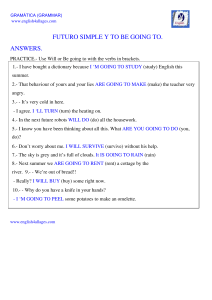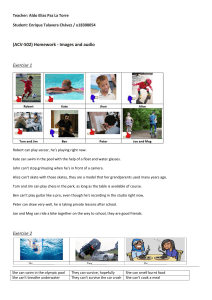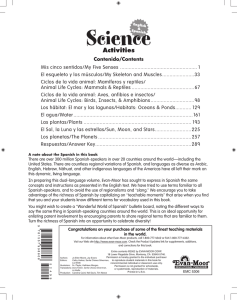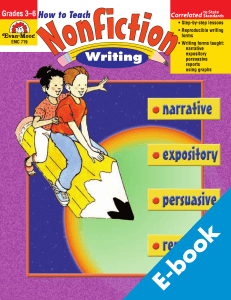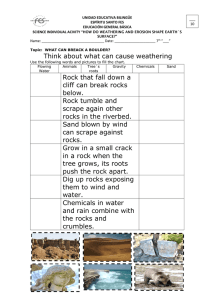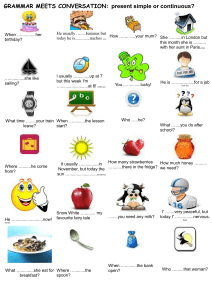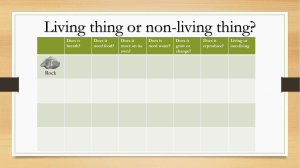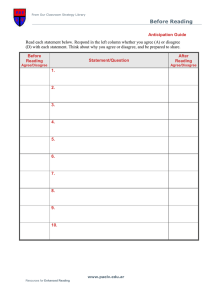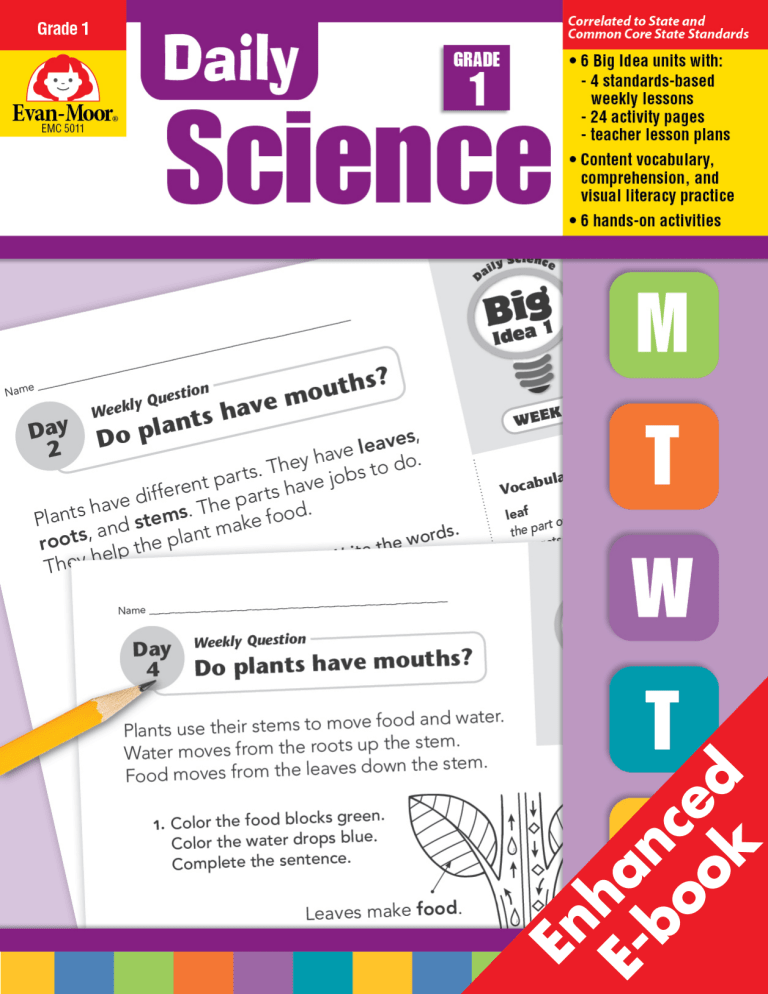
En h E- an bo c ok ed Correlated to State and Common Cor Core State Standards Two resources to help save you time and money. Visit teaching-standards.com to view a correlation of this book. Daily Science Student Book 5-Packs Save up to 30% on copying costs and say goodbye to the hassle of photocopying activities for every student in your class. Student practice books are an easy way to save money while also providing all of your students with their very own book. Grade 1 EMC 6621 Grade 4 EMC E MC 6624 Grade 2 EMC 6622 Grade 5 EMC MC 6625 Grade 3 EMC 6623 Grade 6+ EMC 6626 Student practice books are a sole source product and are only available for purchase directly from Evan-Moor Educational Publishers. To purchase student books, visit www.evan-moor.com. Try this APP for FREE evan-moor.com/apps Daily Science Interactive Courseware Enhance interactive instruction! • • • • 180 interactive lessons Self-correcting Guided skills practice Works with any computer, interactive whiteboard, or projection system Grade 1 EMC 6811 Grade 4 EMC 6814 Grade 2 EMC 6812 Grade 5 EMC 6815 Grade 3 EMC 6813 Grade 6+ EMC 6816 Evan-Moor® Helping Children Learn Thank you for purchasing an Evan-Moor e-book! Attention Acrobat Reader Users: In order to use this e-book you need to have Adobe Reader 8 or higher. To download Adobe Reader for free, visit www.adobe.com. Using This E-book This e-book can be used in a variety of ways to enrich your classroom instruction. You can: • engage students by projecting this e-book onto an interactive whiteboard • save paper by printing out only the pages you need • find what you need by performing a keyword search … and much more! For helpful teaching suggestions and creative ideas on how you can use the features of this e-book to enhance your classroom instruction, visit www.evan-moor.com/ebooks. User Agreement With the purchase of Evan-Moor electronic materials, you are granted a single-user license which entitles you to use or duplicate the content of this electronic book for use within your classroom or home only. Sharing materials or making copies for additional individuals or schools is prohibited. Evan-Moor Corporation retains full intellectual property rights on all its products, and these rights extend to electronic editions of books. If you would like to use this Evan-Moor e-book for additional purposes not outlined in the single-user license (described above), please visit www.evan-moor.com/help/copyright.aspx for an Application to Use Copyrighted Materials form. This page intentionally left blank GRADE 1 Editorial Development: Penny Atcheson James Spears Andrea Weiss Copy Editing: Roseann Erwin Cathy Harber Art Direction: Cheryl Puckett Illustration: Ruth Linstromberg Design/Production: Susan Lovell Olivia C. Trinidad John D. Williams EMC 5011 Evan-Moor® Helping Children Learn Visit teaching-standards.com to view a correlation of this book. This is a free service. Correlated to State and Common Core State Standards Congratulations on your purchase of some of the finest teaching materials in the world. Photocopying the pages in this book is permitted for single-classroom use only. Making photocopies for additional classes or schools is prohibited. For information about other Evan-Moor products, call 1-800-777-4362, fax 1-800-777-4332, or visit our Web site, www.evan-moor.com. Entire contents © 2009 EVAN-MOOR CORP. 18 Lower Ragsdale Drive, Monterey, CA 93940-5746. Printed in USA. CPSIA: Bang Printing, 28210 N. Avenue Stanford, Valencia, CA 91355 [5/2015] Contents What’s in This Book?? . . . . . . . . . . . . . . . . . . . . . . . . . . . . . . . . . . . . . . . . . . . . . . . . . . . . . . 4 Big Idea 1: Vocabulary Living things have basic needs that help them stay alive . . . 6 energy, fresh water, gills, grow, leaf, living, mouth, nonliving, roots, salt water, stem, survive Week 1: Can a rock grow? . . . . . . . . . . . . . . . . . . . . . . . . . . . . . . . . . . . . . . . . . . . . . 8 Week 2: Do monkeys really eat bananas? . . . . . . . . . . . . . . . . . . . . . . . . . . . . . . 14 Week 3: Do plants have mouths? . . . . . . . . . . . . . . . . . . . . . . . . . . . . . . . . . . . . . . 20 Week 4: Do fish drink water? . . . . . . . . . . . . . . . . . . . . . . . . . . . . . . . . . . . . . . . . . . 26 Week 5: Unit Review: Comprehension, Vocabulary, Visual Literacy . . . . . 32 Hands-on Activity: Watch a Plant Drink! . . . . . . . . 35 Big Idea 2: Vocabulary Plants and animals live in many different places . . . . . . . . . . . . 36 camel, den, desert, evergreen, forest, habitat, krill, lake, leaves, nest, ocean, stores, whale Week 1: Where do animals sleep? . . . . . . . . . . . . . . . . . . . . . . . . . . . . . . . . . . . . . 38 Week 2: Why do camels have humps? . . . . . . . . . . . . . . . . . . . . . . . . . . . . . . . . . 44 Week 3: Can a whale live in a lake? . . . . . . . . . . . . . . . . . . . . . . . . . . . . . . . . . . . . 50 Week 4: Why do trees have different kinds of leaves? . . . . . . . . . . . . . . . . . . 56 Week 5: Unit Review: Comprehension, Vocabulary, Visual Literacy . . . . . 62 Hands-on Activity: Look at a Leaf. f . . . . . . . . . . . . . . 65 Big Idea 3: Vocabulary The sun, moon, and stars are objects in our sky y . . . . . . . . . . . . 66 crater, day, Earth, energy, heat, light, moon, mountain, night, planet, rotates, stars, sun Week 1: What causes day and night? . . . . . . . . . . . . . . . . . . . . . . . . . . . . . . . . . . 68 Week 2: What do we see in the sky at night? . . . . . . . . . . . . . . . . . . . . . . . . . . 74 Week 3: Why do we need the sun? . . . . . . . . . . . . . . . . . . . . . . . . . . . . . . . . . . . . 80 Week 4: Can anything live on the moon? . . . . . . . . . . . . . . . . . . . . . . . . . . . . . . 86 Week 5: Unit Review: Comprehension, Vocabulary, Visual Literacy . . . . . 92 Hands-on Activity: Moon Phase Fun . . . . . . . . . . . . 95 2 Daily Science • EMC 5011 • © Evan-Moor Corp. Big Idea 4: Vocabulary Different seasons have different weatherr . . . . . . . . . . . . . . . . . . 96 autumn, axis, bloom, breeze, fall, flowers, gust, icicles, orbit, rain, season, snow, snowflakes, spring, summer, temperature, thermometer, wind, winter Week 1: Why is it hot in the summer? . . . . . . . . . . . . . . . . . . . . . . . . . . . . . . . . 98 Week 2: Why does it snow in the winter? . . . . . . . . . . . . . . . . . . . . . . . . . . . . . 104 Week 3: Why are there a lot of flowers in the spring? . . . . . . . . . . . . . . . . . 110 Week 4: Why do some trees lose their leaves in the fall? . . . . . . . . . . . . . . 116 Week 5: Unit Review: Comprehension, Vocabulary, Visual Literacy . . . . 122 Hands-on Activity: Measure the Wind! . . . . . . . . 125 Big Idea 5: Vocabulary Objects can be solid, liquid, or gas . . . . . . . . . . . . . . . . . . . . . . . . . 126 flows, gas, heat, ice, liquid, mass, matter, melts, mixture, shape, solid, splash, steam Week 1: Why can’t we walk through walls? . . . . . . . . . . . . . . . . . . . . . . . . . . . 128 Week 2: Why does water splash? . . . . . . . . . . . . . . . . . . . . . . . . . . . . . . . . . . . . . 134 Week 3: Why do balloons float in the air?. . . . . . . . . . . . . . . . . . . . . . . . . . . . . 140 Week 4: Why does ice melt? . . . . . . . . . . . . . . . . . . . . . . . . . . . . . . . . . . . . . . . . . . 146 Week 5: Unit Review: Comprehension, Vocabulary, Visual Literacy . . . . 152 Hands-on Activity: Ice Cube Race . . . . . . . . . . . . . 155 Big Idea 6: Vocabulary An object’s motion can be changed by using force . . . . . . . . 156 backward, distance, force, forward, gravity, motion, path, pull, push, speed, wheel Week 1: Why do shopping carts have wheels? . . . . . . . . . . . . . . . . . . . . . . . . 158 Week 2: Why does a ball go far when I kick it hard? . . . . . . . . . . . . . . . . . . 164 Week 3: Why do cars have steering wheels? . . . . . . . . . . . . . . . . . . . . . . . . . . 170 Week 4: Why do things fall down when you drop them? . . . . . . . . . . . . . 176 Week 5: Unit Review: Comprehension, Vocabulary, Visual Literacy . . . . 182 Hands-on Activity: Forces on the Playground . . 185 Answer Key y . . . . . . . . . . . . . . . . . . . . . . . . . . . . . . . . . . . . . . . . . . . . . . . . . . . . . . . . . . . . . . . . 186 © Evan-Moor Corp. • EMC 5011 • Daily Science 3 What’s in This Book? Daily Science provides daily activity pages grouped into six units, called Big Ideas, that explore a wide range of topics based on the national standards for life, earth, and physical sciences. Every Big Idea includes five weekly lessons. The first four weeks each center around an engaging question that taps into students’ natural curiosity about the world to develop essential concepts and content vocabulary. The fifth week of each unit offers a hands-on activity and review pages for assessment and extra practice. The short 10- to 15-minute activities in Daily Sciencee allow you to supplement your science instruction every day while developing reading comprehension and practicing content vocabulary. Unit Introduction Key science concepts and national science standards covered in the unit are indicated. 1 ea a Living things have basic needs that help them stay alive. Unit Overview WEEK 1: Can a rock grow? WEEK 4: Do fish drink water? Key Concept Connection to the Big Idea: Students learn that there are differences between living and nonliving things. They begin by comparing the needs of a rock to their own needs. They then look at inanimate objects and discuss how living things have basic needs, while nonliving things do not. Students then discuss how rocks are not living but animals and plants are living due to their similar basic needs. Connection to the Big Idea: Having previously learned that all living things need water, students now focus on fish living in either fresh water (lakes and rivers) or salt water (oceans). Students learn that freshwater fish take in water through their gills, while saltwater fish drink through their mouths. Their gills remove the salt from their bodies. Needs of Living Things National Standard Organisms have basic needs. For example, animals need air, water, and food; plants require air, water, nutrients, and light. I n this unit, students will compare criteria that define living versus nonliving things. They will understand that plants and animals have basic needs in order to exist, whereas inanimate items, such as rocks, do not. Background information is provided on the topic, giving you the knowledge you need to present the unit concepts confidently. When young students discuss basic needs and the differences between living and nonliving things, they may have some confusion about what defines living. They may not understand that plants are living in the same sense that animals are living. By focusing on this Big Idea, students will learn that: living things have basic needs, while nonliving things do not; specific foods are a basic need for animals; light is a nutrient, or “food,” for plants; and Teacher Background What is alive versus what isn’t alive may seem obvious, yet what makes something alive is a mystery to most young children. Living things can be complex, such as a human, or they can be made from a single cell, such as an amoeba. Because cells are too small for the human eye to see, the idea of such a small thing being the building block of life is difficult for children to comprehend. They might consider living things as animals or bodies. Scientists have developed criteria to compare living versus nonliving things and to study how living organisms survive. This includes how different living things eat, breathe, drink, grow, adapt, reproduce, and die. For children, it’s easy to understand the most basic needs of survival. Those basic needs are air, water, and food. These are needs that, if unfilled, would result in death. For purposes of this unit, plants are also taught as having the same basic needs. The only difference is in the type of food that plants require. While this unit will not go into detail about photosynthesis, students will get an idea of how light is like a plant’s food. For specific background information on each week’s concepts, refer to the notes on pp. 8, 14, 20, and 26. water is a basic need for all living things. 6 Big Idea 1 • Week 1 An overview of the four weekly lessons shows you each weekly question, explains what students will learn, and lists content vocabulary. Content Vocabulary: fresh water, gills, mouth, salt water Content Vocabulary: grow, living, nonliving, survive WEEK 5: Unit Review WEEK 2: Do monkeys really eat bananas? You may choose to do these activities to review the concepts of basic needs and living and nonliving things. Connection to the Big Idea: Students learn that animals need to eat different things to survive. Students begin by discussing that living things eat food to get energy. They then discuss what constitutes food for some living things, and how animals eat different things depending on where they live. p. 32: Comprehension Students circle pictures to answer questions about key concepts in the unit. p. 33: Vocabulary Students answer riddles using content vocabulary from the unit. p. 34: Visual Literacy Students label the parts of a plant and a fish. Content Vocabulary: energy WEEK 3: Do plants have mouths? Week five review activities are summarized. p. 35: Hands-on Activity Students see how plants drink by placing celery in a glass of colored water. The instructions and materials are listed on the student page. Review these and gather the materials ahead of time. Connection to the Big Idea: Students learn that, as living things, plants require food and water. Students investigate what is considered food for plants, how plants get energy, and how plants might eat without mouths. They look at the basic structure of plants. Then they are introduced to the concept that a plant’s leaves take in sunlight to make food, the roots absorb water, and the stem moves nutrients and water. Content Vocabulary: leaf, roots, stem Daily Science • EMC 5011 • © Evan-Moor Corp. Big Idea 1 • Week 1 © Evan-Moor Corp. • EMC 5011 • Daily Science 7 Weekly Lessons (Weeks 1– 4) Each week begins with a teacher page that provides additional background information specific to the weekly question. Week 1 Can a rock grow? Rocks cannot grow like plants and animals do, because rocks are not Da i l y S c i e nc Weekly Question Can a rock grow? things. One is that living things grow and change. A nonliving thing does not. A pebble will never “grow” into a rock. The other characteristic Living things have is that living things have basic needs that help them stay alive. Animals basic needs that need air, water, and food. Plants require nutrients and light. When these help them stay alive. needs are met, living things are able to grow and change. Day One Vocabulary: grow Materials: plant, ball Vocabulary: living 4 Day 1 living things. Two main characteristics distinguish living from nonliving Day Two Ideas are given for presenting the daily activity pages, including content vocabulary and materials needed for any demonstrations or group activities. Name __________________________________________________________ Day Three Vocabulary: survive Day Four Vocabulary: nonliving Materials: stuffed animal, rock Day Five 8 Big Idea 1 • Week 1 Some things grow, w and some things do not. 1. What do you think can grow? Circle your guesses. grow to get bigger Distribute page 9. Hold up a plant or a picture of a plant and say: A plant is living. So it grows. Hold up a ball or a picture of a ball and say: A ball is not living. It does not grow. Complete the first two activities on page 9 together. For activity 3, help students brainstorm things that grow and change at home. (pets, siblings, plants, etc.) Make a list on the board. Have students choose one word to copy in the box and draw a picture of it. Distribute page 10 and read aloud the vocabulary word (living). Tell students to listen for the word living g as you read the introduction aloud. When they hear the word, they should raise their hands. Next, point to the picture of the chick. Ask: Does a chick grow? (yes) Ask: Is a chick living? (yes) Point to the picture of the hen and say: A chick grows into a hen. Read the question on page 10. Then ask: What does a puppy grow into? (a dog) Say: Draw a line from the puppy to the dog. Have students finish the activity. For activity 2, read the sentence aloud and have students write the word. Distribute page 11 and read the introduction aloud. Ask students to imagine that the classroom is a spaceship. Ask: For us to survive, what needs to be on our spaceship? (food, water, air) Complete the first two activities together. For activity 3, distribute crayons and then point out each item and ask: Does a dog need this to survive? WEEK 1 Vocabulary 2. Complete the sentence. Write the word. Some things 3. . What grows and changes at your home? Write the word. Draw a picture of it. Hold up a stuffed animal. Ask: Does this grow? (no) Ask: Does this need air, water, and food? (no) Say: That means a stuffed animal is nonliving. Distribute page 12 and read aloud the introduction, making sure to emphasize the word nonliving. Guide students through the first two activities. For activity 3, help students brainstorm nonliving things in the classroom. (books, maps, desks) Make a list on the board. Have students copy four words onto their page. For activity 4, read aloud the sentence and have students write the word. Tell students they are going to review what they’ve learned about living and nonliving things. Distribute crayons and complete page 13 together. Daily Science • EMC 5011 • © Evan-Moor Corp. © Evan-Moor Corp. • EMC 5011 • Daily Science Big Idea 1 • Week 1 9 The student activity pages for Days 1–4 of each week use an inquiry-based model to help students answer the weekly question and understand fundamental concepts related to the Big Idea. You may wish to have students complete the pages independently or collaboratively. Daily Science • EMC 5011 • © Evan-Moor Corp. Weekly Lessons, continued Da Name __________________________________________________________ Each student page begins with a short introduction. Day 2 i l y S c i e nc Can a rock grow? Activities include a variety of writing, comprehension, vocabulary, critical thinking, visual literacy, and oral language practice. Name __________________________________________________________ Day 4 WEEK 1 Vocabulary Vocabulary living g Da Can a rock grow? Living things need food, water, and air. These help living things survive. Food, water, and air also help living things grow and change. WEEK 1 1 1. Da Name __________________________________________________________ Day 5 Can a rock grow? survive to stay living Complete the sentence. Write the w word. i l y S c i e nc Weekly Question i l y S c i e nc Weekly Question Day 3 Only living things can grow. An animal is a living thing. A plant is a living thing. Living things grow and change. Da Name __________________________________________________________ Weekly Question rr, i l y S c i e nc . Weekly Question Can a rock grow? o. A rock is nonliving. It does not grow and change. It does not need food, water, or air. 1. 1. WEEK 1 Color the picture of a living thing. Teddy Bear WEEK 1 Big Bear Vocabulary Put an X on the nonliving things. yes no yes no yes no nonliving not having life rvive. 2. How are all nonliving things alike? Fill in the bubble next to the correct answer. 2. $ They don’t need food, water, or air. % They move and breathe. & They grow and change. 3. List four nonliving things in your classroom. 3. Look at the bears again. Circle yes or no. Teddy Bear grows. yes no Big Bear is living. yes no Big Bear eats. yes no nonliving A rock is Complete the sentence. Write the word. 12 . Big Idea 1 • Week 1 . . I need air, water, and food to . Big Idea 1 • Week 1 © Evan-Moor Corp. • EMC 5011 • Daily Science Daily Science • EMC 5011 • © Evan-Moor Corp. 11 Vocabulary words and definitions are provided for students. survive A butterfly is A rock is Big Idea 1 • Weekk 1 Complete the sentences. Use the words in the box. living 4. water Day 5 reviews the week’s key concepts and vocabulary. 13 Unit Review (Week 5) Visual Literacy: Students practice skills such as labeling diagrams, reading captions, and sequencing steps in a process. Comprehension: Students review key concepts of the unit by answering literal and inferential comprehension questions. Hands-on Activity: Students participate in a hands-on learning experience. Da Name __________________________________________________________ __ i l y S c i e nc Unit Visual Literacy Review w Picture This! 1. Unit Hands-on Activity Review Watch a Plant WEEK 5 Use the words to write the parts of the plant. leaf D Name __________________________________________________________ __ Unit Comprehension Review Needs of Living D Name __________________________________________________________ c WEEK 5 Which of these is living? Read each riddle. Circle the correct word. 1. I am very big. We are part of a plant. ocean mouth leaves 1. Stir red food coloring into the water. • celery stalk with leaves 2. Have an adult help you cut the bottom off the celery stalk. 3. Put the celery in the colored water. Leave it alone for a whole day. 4. Check to see what happened! I am part of a fish. • safety scissors • crayons Color the celery to show what happened. Talk Tell your partner what happened to the celery. What does a monkey eat? 3. • glass of water gills roots We help the plant make food. 2. WEEK 5 What You Need What Did You Discover? WEEK 5 lake I am full of salty water. 2. roots stem Unit Vocabulary Review Find a Word Things Read each question. Circle the answer. 1. c y S c i en ail i l y S c i e nc Drink! You can see how a plant drinks water. Try this test. • red food coloring y S c ien ail Da Name __________________________________________________________ __ river gills stem energy living nonliving grow survive e I help the fish get water. 4. 3. I help you do work. © Evan-Moor Corp. You get me from food. What plant part makes food? 5. I am not like you. © Evan-Moor Corp. • EMC 5011 • Daily Science Big Idea 1 • Week 5 35 I describe a rock. 4. 32 6. Which of these will grow? Big Idea 1 • Week 5 When I do this, I change. Vocabulary: Students review the vocabulary presented in the unit. I get bigger and taller. Daily Science • EMC 5011 • © Evan-Moor Corp. © Evan-Moor Corp. • EMC 5011 • Daily Science © Evan-Moor Corp. • EMC 5011 • Daily Science Big Idea 1 • Week 5 33 5 Living things have basic needs that help them stay alive. 1 ea a I n this unit, students will compare criteria that define living versus nonliving things. They will understand that plants and animals have basic needs in order to exist, whereas inanimate items, such as rocks, do not. When young students discuss basic needs and the differences between living and nonliving things, they may have some confusion about what defines living. They may not understand that plants are living in the same sense that animals are living. By focusing on this Big Idea, students will learn that: living things have basic needs, while nonliving things do not; specific foods are a basic need for animals; light is a nutrient, or “food,” for plants; and Key Concept Needs of Living Things National Standard Organisms have basic needs. For example, animals need air, water, and food; plants require air, water, nutrients, and light. Teacher Background What is alive versus what isn’t alive may seem obvious, yet what makes something alive is a mystery to most young children. Living things can be complex, such as a human, or they can be made from a single cell, such as an amoeba. Because cells are too small for the human eye to see, the idea of such a small thing being the building block of life is difficult for children to comprehend. They might consider living things as animals or bodies. Scientists have developed criteria to compare living versus nonliving things and to study how living organisms survive. This includes how different living things eat, breathe, drink, grow, adapt, reproduce, and die. For children, it’s easy to understand the most basic needs of survival. Those basic needs are air, water, and food. These are needs that, if unfulfilled, would result in death. For purposes of this unit, plants are also taught as having the same basic needs. The only difference is in the type of food that plants require. While this unit will not go into detail about photosynthesis, students will get an idea of how light is like a plant’s food. For specific background information on each week’s concepts, refer to the notes on pp. 8, 14, 20, and 26. water is a basic need for all living things. 6 Big Idea 1 • Week 1 Daily Science • EMC 5011 • © Evan-Moor Corp. Unit Overview WEEK 1: Can a rock grow? WEEK 4: Do fish drink water? Connection to the Big Idea: Students learn that there are differences between living and nonliving things. They begin by comparing the needs of a rock to their own needs. They then look at inanimate objects and discuss how living things have basic needs, while nonliving things do not. Students then discuss how rocks are not living but animals and plants are living due to their similar basic needs. Connection to the Big Idea: Having previously learned that all living things need water, students now focus on fish living in either fresh water (lakes and rivers) or salt water (oceans). Students learn that freshwater fish take in water through their gills, while saltwater fish drink through their mouths. Their gills remove the salt from their bodies. Content Vocabulary: grow, living, nonliving, survive WEEK 2: Do monkeys really eat bananas? Connection to the Big Idea: Students learn that animals need to eat different things to survive. Students begin by discussing that living things eat food to get energy. They then discuss what constitutes food for some living things, and how animals eat different things depending on where they live. Content Vocabulary: energy WEEK 3: Do plants have mouths? Connection to the Big Idea: Students learn that, as living things, plants require food and water. Students investigate what is considered food for plants, how plants get energy, and how plants might eat without mouths. They look at the basic structure of plants. Then they are introduced to the concept that a plant’s leaves take in sunlight to make food, the roots absorb water, and the stem moves nutrients and water. Content Vocabulary: fresh water, gills, mouth, salt water WEEK 5: Unit Review You may choose to do these activities to review the concepts of basic needs and living and nonliving things. p. 32: Comprehension Students circle pictures to answer questions about key concepts in the unit. p. 33: Vocabulary Students answer riddles using content vocabulary from the unit. p. 34: Visual Literacy Students label the parts of a plant and a fish. p. 35: Hands-on Activity Students see how plants drink by placing celery in a glass of colored water. The instructions and materials are listed on the student page. Review these and gather the materials ahead of time. Content Vocabulary: leaf, roots, stem © Evan-Moor Corp. • EMC 5011 • Daily Science Big Idea 1 • Week 1 7 Week 1 Can a rock grow? Rocks cannot grow like plants and animals do, because rocks are not living things. Two main characteristics distinguish living from nonliving things. One is that living things grow and change. A nonliving thing does not. A pebble will never “grow” into a rock. The other characteristic Living things have is that living things have basic needs that help them stay alive. Animals basic needs that need air, water, and food. Plants require nutrients and light. When these help them stay alive. needs are met, living things are able to grow and change. Day One Distribute page 9. Hold up a plant or a picture of a plant and say: A plant is living. So it grows. Hold up a ball or a picture of a ball and say: A ball is not living. It does not grow. Complete the first two activities on page 9 together. For activity 3, help students brainstorm things that grow and change at home. (pets, siblings, plants, etc.) Make a list on the board. Have students choose one word to copy in the box and draw a picture of it. Vocabulary: grow Materials: plant, ball Day Two Vocabulary: living Day Three Vocabulary: survive Day Four Vocabulary: nonliving Materials: stuffed animal, rock Day Five 8 Big Idea 1 • Week 1 Distribute page 10 and read aloud the vocabulary word (living). Tell students to listen for the word living g as you read the introduction aloud. When they hear the word, they should raise their hands. Next, point to the picture of the chick. Ask: Does a chick grow? (yes) Ask: Is a chick living? (yes) Point to the picture of the hen and say: A chick grows into a hen. Read the question on page 10. Then ask: What does a puppy grow into? (a dog) Say: Draw a line from the puppy to the dog. Have students finish the activity. For activity 2, read the sentence aloud and have students write the word. Distribute page 11 and read the introduction aloud. Ask students to imagine that the classroom is a spaceship. Ask: For us to survive, what needs to be on our spaceship? (food, water, air) Complete the first two activities together. For activity 3, distribute crayons and then point out each item and ask: Does a dog need this to survive? Hold up a stuffed animal. Ask: Does this grow? (no) Ask: Does this need air, water, and food? (no) Say: That means a stuffed animal is nonliving. Distribute page 12 and read aloud the introduction, making sure to emphasize the word nonliving. Guide students through the first two activities. For activity 3, help students brainstorm nonliving things in the classroom. (books, maps, desks) Make a list on the board. Have students copy four words onto their page. For activity 4, read aloud the sentence and have students write the word. Tell students they are going to review what they’ve learned about living and nonliving things. Distribute crayons and complete page 13 together. Daily Science • EMC 5011 • © Evan-Moor Corp. Name __________________________________________________________ Day 1 i l y S c i e nc Weekly Question Can a rock grow? Some things grow, w and some things do not. 1. Da What do you think can grow? Circle your guesses. WEEK 1 Vocabulary grow to get bigger 2. Complete the sentence. Write the word. Some things 3. . What grows and changes at your home? Write the word. Draw a picture of it. © Evan-Moor Corp. • EMC 5011 • Daily Science Big Idea 1 • Week 1 9 Da Name __________________________________________________________ Idea 1 Can a rock grow? Only living things can grow. An animal is a living thing. A plant is a living thing. Living things grow and change. 1. 2. WEEK 1 Vocabulary What does each living thing grow into? Draw lines to match. • • • • • • e Big Weekly Question Day 2 i l y S c i e nc living having life Complete the sentence. Write the word. A thing changes as it grows. 10 Big Idea 1 • Week 1 Daily Science • EMC 5011 • © Evan-Moor Corp. Da Name __________________________________________________________ Day 3 i l y S c i e nc e Big Weekly Question Idea 1 Can a rock grow? Living things need food, water, and air. These help living things survive. Food, water, and air also help living things grow and change. WEEK 1 Vocabulary 1. survive to stay living Complete the sentence. Write the word. Living things need food, water, and air to 2. 3. . Read each sentence. Circle yes or no. A cat needs food to survive. yes no A tree needs air to survive. yes no A baby needs toys to survive. yes no Color the things a dog needs to survive. food ball © Evan-Moor Corp. • EMC 5011 • Daily Science water Big Idea 1 • Week 1 11 Da Name __________________________________________________________ Idea 1 Can a rock grow? A rock is nonliving. It does not grow and change. It does not need food, water, or air. Vocabulary Put an X on the nonliving things. 2. How are all nonliving things alike? Fill in the bubble next to the correct answer. nonliving not having life don’t need food, water, or air. % They move and breathe. & They grow and change. 3. List four nonliving things in your classroom. 4. Complete the sentence. Write the word. A rock is 12 WEEK 1 1. $ They Big Idea 1 • Week 1 e Big Weekly Question Day 4 i l y S c i e nc . Daily Science • EMC 5011 • © Evan-Moor Corp. Da Name __________________________________________________________ Day 5 1. Weekly Question Can a rock grow? Color the picture of a living thing. Teddy Bear 2. 3. i l y S c i e nc WEEK 1 Big Bear Look at the bears again. Circle yes or no. Teddy Bear grows. yes no Big Bear is living. yes no Big Bear eats. yes no Complete the sentences. Use the words in the box. living nonliving A rock is survive . A butterfly is I need air, water, and food to © Evan-Moor Corp. • EMC 5011 • Daily Science . . Big Idea 1 • Week 1 13 Week 2 Do monkeys really eat bananas? There are over 250 different species of monkeys. Most types of monkeys eat fruit and leaves, though some monkeys eat insects, other plant Living things have parts, and even some rodents. Like every animal, the monkey’s diet basic needs that depends on where it lives. Monkeys that live in a place that grows help them stay alive. bananas will eat bananas. But if a monkey doesn’t live near a banana tree, it will find something else to eat. Monkeys are intelligent and willing to try new things, especially if their usual food cannot be found. Day One Vocabulary: energy Day Two Materials: pictures of food Say: All living things need food. Food gives us energy. We need energy to move, think, play, work, and stay alive. Have students make a prediction. Ask: Do you think monkeys eat bananas? Why? (Yes. Bananas give monkeys energy.) Distribute page 15 and complete it with students. Say: People eat many kinds of food. Different foods give us energy. They are good for us. Hold up each picture of food and have students raise their hands if they would eat the food in the picture. Distribute page 16 and have students complete the first item. For activity 2, make a list on the board of students’ favorite foods. Have students copy a food word and draw its picture. Day Three Say: People eat food that is grown all over the world. But animals must eat food that grows where they live. Ask: Do bananas grow at the North Pole? (no) Does a cactus grow in the jungle? (no) Distribute page 17 and read the introduction aloud. Then guide students through the first activity, helping them identify where each animal lives. For activity 2, read each sentence aloud and have students circle their answers. Day Four Explain that animals eat food that they can find easily. Say: Cows don’t eat fruit because they can’t climb trees. Monkeys don’t eat rice because they can’t grow it or pick it. Distribute page 18. After students have completed the first activity, have them discuss their favorite foods in pairs or as a group. Day Five Tell students they are going to review what they’ve learned about food. Have them complete page 19. Go over the answers together. 14 Big Idea 1 • Week 2 Daily Science • EMC 5011 • © Evan-Moor Corp. Da Name __________________________________________________________ Day 1 Weekly Question Do monkeys really eat bananas? Living things eat food to get energy. 1. 2. i l y S c i e nc WEEK 2 Draw a line from each animal to a food it eats for energy. • • bananas • • grass • • fish • • worms Vocabulary energy the power to do work Complete each sentence. Write the word. Monkeys eat to get We eat to get © Evan-Moor Corp. • EMC 5011 • Daily Science . . Big Idea 1 • Week 2 15 Da Name __________________________________________________________ Day 2 Weekly Question Do monkeys really eat bananas? People eat many kinds of food to get energy. 1. Circle the things people eat. 2. Draw a picture of what you eat to get energy. Then complete the sentence about it. I eat 16 i l y S c i e nc Big Idea 1 • Week 2 WEEK 2 to get energy. Daily Science • EMC 5011 • © Evan-Moor Corp. Da Name __________________________________________________________ Day 3 Weekly Question Do monkeys really eat bananas? Animals need food to get energy. They eat food that grows where they live. 1. WEEK 2 Draw lines to match the animals with where they get their food. • • monkey field • • cow South Pole • • penguin 2. i l y S c i e nc jungle Read each sentence. Circle yes or no. A monkey eats fish. yes no A penguin eats bananas. yes no A cow eats grass. yes no © Evan-Moor Corp. • EMC 5011 • Daily Science Big Idea 1 • Week 2 17 Da Name __________________________________________________________ Day 4 i l y S c i e nc Weekly Question Do monkeys really eat bananas? Animals eat food that is easy to get. WEEK 2 Circle the food that is easy for each animal to get. Talk Discuss with your partner what you like to eat every day. 18 Big Idea 1 • Week 2 Daily Science • EMC 5011 • © Evan-Moor Corp. Da Name __________________________________________________________ Day 5 1. 2. Weekly Question Do monkeys really eat bananas? Read each sentence. Circle yes or no. WEEK 2 Animals need food to live. yes no Animals eat food that grows where they live. yes no All animals can eat anything. yes no People eat food to get energy. yes no Draw a picture of each thing. Something you eat 3. i l y S c i e nc Something a monkey eats Read the question. Circle yes or no. Do monkeys eat bananas? © Evan-Moor Corp. • EMC 5011 • Daily Science yes no Big Idea 1 • Week 2 19 Week 3 Do plants have mouths? Through the process of photosynthesis, plants make food by taking in light through their leaves. The leaves contain a chemical called chlorophyll, which is what makes the leaves green. Plants use their roots to bring in water that is full of nutrients from the soil. They absorb Living things have basic needs that help them stay alive. sunlight and carbon dioxide through their leaves. The leaves use the water and nutrients from the roots, along with the sunlight and carbon dioxide, to make the special sugar that the plant uses for energy. Although students will not learn all of these scientific terms, they will begin to gain an understanding of how plants make food. Day One Materials: a plant or picture of a plant Day Two Vocabulary: leaf, roots, stem Ask: What do people eat? Hold up the plant or picture of a plant. Have students make a prediction by asking: What do you think this plant eats? Allow volunteers to make their prediction. Distribute page 21 and read the introduction aloud. For the first activity, ask: Does a plant need light? (yes) Say: Circle the picture of the sun. Does a plant need a house? (no) Say: Don’t circle that picture. When students have finished, help them complete activity 2. Tell students that plants need certain things to make food. Say: Food for plants is different from food for people. Plants make their own food with special parts. I wonder what those parts are. Distribute page 22 and read the introduction aloud. When students have finished the first activity, distribute crayons and read the directions for the second activity. Day Three Distribute page 23 and read the introduction aloud. Point out the parts of the plant. Say: Plants make food with their leaves and roots. For the first activity, read each sentence aloud and have students write the words. For the second activity, read each sentence aloud and have students circle their answers. Day Four Distribute page 24. Say: The stem helps the plant grow tall. Leaves and roots connect to the stem. Then read aloud the introduction. Distribute crayons and guide students through the first activity. Then have students complete the second activity on their own. Day Five Tell students they are going to review everything they’ve learned about how plants get food and water. Help them complete page 25. Go over the answers together. 20 Big Idea 1 • Week 3 Daily Science • EMC 5011 • © Evan-Moor Corp. Name __________________________________________________________ Day 1 Da i l y S c i e nc Weekly Question Do plants have mouths? Plants make their own food. They need air, light, and water to make food. WEEK 3 1. Draw lines from the plant to the things it needs to make food. 2. Complete the sentence. Write the word. A plant uses air, light, and water to make © Evan-Moor Corp. • EMC 5011 • Daily Science . Big Idea 1 • Week 3 21


